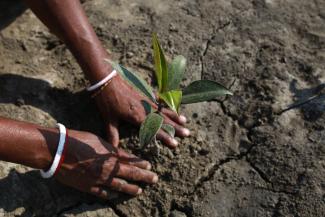
Climate change impacts life and livelihoods. Economic sectors that generate around US$44 trillion annually depend on a strong ecosystem, and biodiversity loss can create financial challenges for governments, industries, and people who depend on agriculture, fisheries, and tourism for survival. Nature-related risks will impact fiscal and financial stability, affecting governments, central banks, and finance ministries.
This is the sombre scenario painted by Mr Muthukumara S. Mani, Lead Environmental and Climate Change Economist at The World Bank, who delivered the first keynote at the Nature Finance Conference, co-organised by Sim Kee Boon Institute for Financial Economics (SKBI) and the Singapore Green Finance Centre (SGFC) of the Singapore Management University. The conference saw some 100 attendees from academia, government and the banking sector and featured over 20 speakers.
Despite the calls to unlock investments for conservation, restoration, and sustainable use of green and blue biodiversity through financing green initiatives, harnessing private finance is difficult due to myriad factors, said Mr Mani. The four key constraints, in his view, are the lack of incentives that encourage conservation rather than the expansion of economic activity, the paucity of standards to measure progress, the lack of corporate reporting requirements on biodiversity risks and the highly localised nature of biodiversity projects.
Complementary role of effective public policies
Mr Mani’s concerns are echoed by Dr Caroline Flammer, Professor of International and Public Affairs and of Climate at Columbia University. She noted that there is a “glaring research gap” in biodiversity finance, probably because of a lack of awareness of how private financing can contribute to biodiversity conservation and restoration and a lack of data on biodiversity finance itself.
Based on her recent research, she found that private capital, whether alone or blended, is unlikely to mitigate the biodiversity crisis. It needs to be complemented with effective public policies, she shared. Though blended finance is in its infancy, it can help enhance the risk-return tradeoffs of such investments and help to catalyse the use of more private capital, she added.
Dealing with the questions that matter
A panel discussion entitled “Can the market save nature?” was moderated by Associate Professor of Finance Hao LIANG of SMU’s Lee Kong Chian Business School. He is also the Co-Director of SGFC and the recipient of Ho Bee Professorship in Sustainability Management.
The panellists were Ms Lim Bey An, Head, Capabilities, Enablers and Futures, within the Sustainability Group at the Monetary Authority of Singapore (MAS), Dr Pernille Holtedahl, Research Fellow, Centre for Climate Finance and Investment (CCFI), Imperial College Business School Ms Kristina Anguelova, Head of Asia Sustainable Finance, World Wide Fund for Nature (WWF); and Mr Mervyn Tang, Head of Sustainability, Asia Pacific, Schroders Singapore. Schroders Singapore is a founding member of the SGFC.
Ms Lim shared that MAS is committed to spurring the ecosystem to understand the impact of biodiversity finance. Dr Holtedahl, who has a passion for private finance, called for more investment in green infrastructure that delivers benefits to the environment, the community and the economy. She cited the example of the Zephyr Wind Farm in Pakistan which invested in mangrove restoration instead of a sea wall to protect against erosion and storm surges. The investment is projected to save millions in maintenance costs and has also increased shrimp and fish populations, thus improving the livelihoods of the local community.
Ms Anguelova highlighted the need to examine harmful subsidies that run into the trillions, and the need for policies and governance structures to be put in place in the management of conservation finance. She also called for more transparency in the supply chains for commodities such as tuna and coffee. Mr Tang, speaking as an asset manager, said it is vital to look also at the biodiversity impact of a portfolio rather than how is affected by biodiversity risks.
“There are going to be solutions for regenerative agriculture, water, sanitation and so on and it is about building a framework to invest in these opportunities,” he said. But more data needs to be available, the panellists agreed. “Nature is complex because of interdependencies and it is difficult to isolate by sectors or issues,” said Ms Anguelova.
“So can the market save nature? In the long run, yes,” said Prof Liang as he concluded the first panel of the conference. “In the short run, there is a lot of resource capital misallocation and it is our role to help put them in the right place.”
He added: “There is a big gap between research and industry practice in the area of nature finance, which is to a large extent due to lack of high-quality data. Hopefully, through this conference, researchers and practitioners in this field could work more closely to address important questions, such as whether investors and financial institutions should care about biodiversity risks, and how to design the blended funding structure to effectively mobilise capital from the private sector to invest in nature. Other vital questions include the trade-off for investors, and how to measure, quantify, and value the impact of nature investment.”
The day-long conference also covered a wide range of topics related to the assessment of risks, disclosure recommendations and innovative solutions. These included a supervisory framework for assessing nature-related financial risks presented by the OECD, TNFD financial disclosure recommendations and biodiversity finance and data innovations from renowned global experts in the sector.
SGFC Centre Director Nikki Kemp said, “The Nature Finance Conference is an example of how the Centre can tackle some of the most intractable issues for sustainable finance in Asia. It’s the tip of the iceberg on this topic with further extensive research planned for 2024.”

